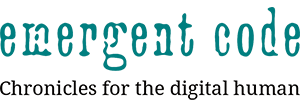
8.0 Biorhythms and definitions
The digital age in its full-blown state incorporates actual and artificial intelligence, us and the internet of things together. It generates knowledge about the value of the relationship between these things, made available as data.
It might seem outlandish, but it’s already inevitable. This is the digital age’s great advantage and what Kevin Kelly has called ‘the technium‘.
Soon, every organisation, every person and every machine on the planet will have its own embedded digital central nervous system.
In this coming connected age, it will virtually be impossible to not be tracked and monitored as part of a wired-up ecology. From cyborg bacteria that can think to aggregated metrics that can measure and create value at a global level.
Ethics and data are colliding now, but where are the diagnostics and the means to know what themes we are running?
As the world becomes enveloped by a digital membrane made of code and data, we have access to ‘meta’ levels of understanding at our disposal, and macro views, as never before.
In the last four years I’ve studied organisations that meet fundamental human needs, in housing, not-for-profits and food service, at scale. What it has shown me is that technology may becoming proprietary but all organisations are not the same.
Balancing unique differentiation and universal standards of digital utility well is part of developing biorhythms and digital definitions. It similar to the taxonomies and classifications we’ve developed for the natural world. How might core functions be delivered, how do different areas of business and social practice need to operate?
For the most part, these are being developed sporadically and haphazardly across many areas of civic and business life where they needn’t be. The time of quantified self and the quantified organisation is upon us, in which we use data and code to illuminate new patterns of understanding.
Data can either help us steer a path towards a new sustainable digital civilisation or leave us at the mercy of the numbers, as we become tiny, plankton-sized parts of an unimaginably large algorithm depending on how well we work collaboratively with technology.
If we think of data as the traceable dynamics of humankind, our digital biorhythms and data definitions will do much for us as digital humans. Data is our future lifeblood, and code can reveal the underpinnings we need to secure our future wellbeing as digital humans.
Issues such as net neutrality and how big data insights are used profoundly shape our future direction. Code is going to be the prime source of our prosperity in the future. So this chapter of Emergent code is an enquiry into the pulse points that are likely to define our positive emergence as digital humans.
It looks at what we might learn and are learning from the study of cities, businesses and human behaviours, designing with data and digital business thinking and the future ways that we can use code to meet fundamental human needs better.


One thought on “8.0 Biorhythms and definitions”
Comments are closed.